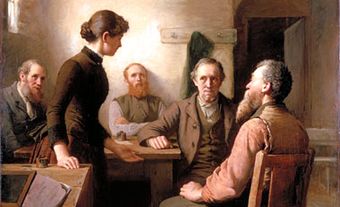Educational Opportunity
Prior to the emergence of compulsory public elementary schooling early in the 19th century, educational opportunities in western European societies were generally grounded in the experiences of particular social classes. For centuries, basic education had been conducted mainly in the household; more advanced forms of training, for select numbers of boys, was the preserve of medieval guilds, monasteries and elite universities. UPPER CANADA and LOWER CANADA reproduced similar forms of education.
The emergence of the capitalist mode of manufacturing with its burgeoning demands for industrial and professional workers and increasingly evident class conflict, however, presented major challenges to the established educational and civil order. The state was called upon, especially by the propertied classes, to provide more training opportunities to meet these demands as well as to contribute to social harmony, through the creation of public elementary schools.
Canadian Vision
In the words of A. Egerton RYERSON, the major architect of the public school system in Upper Canada, public schools would see "the children of the rich and the poor ... commencing the race of life upon equal terms, and cultivating feelings of mutual respect and sympathy, which divest property of its meanness and hatreds, and wealth of its arrogance and selfishness." Claims that the schools should provide equal opportunities, and thereby ensure a democratic social order as well as responding to purported needs for skill upgrading, have been a central feature of the dominant public discourse about educational opportunities ever since.
Vision Attainment
The practice has been somewhat different. While the absolute level of provision of educational opportunities through school systems has expanded almost continuously in Canada since the 1830s, equal provision in terms of class, gender or ethnicity has remained more elusive.
By the mid-20th century, most Canadian children were completing elementary school. Only a minority continued on and eventually completed high school and less than 5% went on to UNIVERSITY . The appearance of the BABY BOOM generation in an economy with rapidly growing demand for a more qualified work force led to massive expansion of post-secondary schooling during the 1960s. COMMUNITY COLLEGES were created, existing universities expanded and new ones built. Participation in post-secondary institutions has continued to increase steadily.
By the end of the 1990s, the vast majority of Canadian youths were completing high school. Over half of these youths were entering colleges or universities - a participation rate only rivaled by the US. Participation rates in organized ADULT EDUCATION programs have also increased rapidly, from about 4% in 1960 to around a third of the adult population by the end of the1990s.
In this context of accelerating economic and technological change, the watchword of educational opportunity has become "lifelong learning". However, the higher the level of schooling and the higher the socioeconomic class or status of one's father, the more years of schooling one is likely to complete. The chances of attaining at least some post-secondary schooling remain at least twice as great for those whose parents had post-secondary schooling as for those whose parents did not go beyond grade 10.
Many visible minorities, such as NATIVE PEOPLE and BLACKS, continue to have much greater school dropout rates. Women have come a long way, from being educated mainly in the household to equal levels of enrolment in post-secondary institutions, but they remain seriously underrepresented in many graduate programs. More generally, those with post-secondary schooling remain much more likely to participate in adult education programs than those with only high school or less. Those who have more schooling, continue to seek out more.
Transitions
Since the 1950s, the focus of public debate about educational opportunities has changed from a general emphasis on "equality of opportunity" to participation for individuals from all social backgrounds, to concern with "equality of condition " for people of different social origins when starting school, to "equality of outcome or achievement" in completing high school and to "equal access" to post-secondary schooling. As more people complete lower levels of schooling, the focus of this debate has shifted to higher levels, where the inequities of exclusion remain more evident.
Retrospective
Critics of formal schooling have frequently argued that formal educational credentials bear little relation to the actual knowledge needed to live and work in industrial market societies. Adult education research has documented that regardless of formal schooling, the vast majority of Canadians are involved in a wide array of self-directed learning opportunities.
The perception, however, that post-secondary credentials are necessary to succeed is now extremely widespread in Canada, and the popular demand for access to such educational opportunities continues to grow while debt-ridden governments attempt to shift more of the enrolment costs directly to the students. The extent of educational opportunities has changed dramatically since the early 19th century, but the struggle for equal opportunities continues.

 Share on Facebook
Share on Facebook Share on X
Share on X Share by Email
Share by Email Share on Google Classroom
Share on Google Classroom


